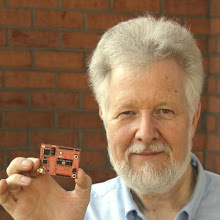Tempus fugit, they say: time is flying away, hopefully not leaving us behind.
Three years are gone since my last blog post on visualFORTH, three years full of successful work.
What happened meanwhile?
I had other work to do. A battery operated audio project with TI's MSP430 microcontroller. I had chosen the only then available part with dual inline contacts, the MSP430F2012, and I had to program with C. I am glad I could copy paste from TI's application program examples, and I am glad that I got it working. But my desire was to use Forth again.
TI's offering of the LaunchPad boards opened a new horizon for low prized Forth controller boards.
Several things happened: there was the FRAM LaunchPad available, to make a Forth dream machine. My friend Michael ported CamelForth onto it, was quite nice, but somehow expensive. Having this porting experience, Michael ported CamelForth onto the MSP430G2553, which I meanwhile had selected for the next audio project generation. There have been dreams since a while about a small nice affordable board with a modern microcontroller unit and a compact
Forth inside, and these dreams came true now.
Just before 4E4th was first promoted at the annual German Forth Chapter meeting March 2012 in Noord–Brabant, Netherlands, TI had changed the LaunchPad design to accommodate the MSP430G2553 which I had chosen for my audio project, meanwhile with 4E4th on chip. With the arrival of the second LaunchPad generation being equipped with the MSP430G2553 the door was open for our Education Initiative:
Forth for Education. This Forth we named 4E4th - Forth for Education - this was the ignition spark.
Next step: we needed a simple Terminal to correspond with 4E4th, and ended up with a complete IDE, an Integrated Development Environment. It started by developing this simple Terminal, and at the end we got everything together: Terminal, Editor, Flasher, and a lot of little helpers. To be able to do so, I was glad to have VisualFORTH, with which the 4E4th-IDE was developed in tandem - several steps of the development needed upgrading of VisualFORTH. That's why there is a gap between take 14 three years ago and take 19 today. Last year at the annual European Forth Conference, the EuroForth in Oxford, Great Britain, was a first presentation of the 4E4th-IDE.
The development of the 4E4th-IDE was under severe pressure to get it ready for the conference. The presentation showed that the 4E4th-IDE was working properly with all it's features, but it wasn't bug free, because to save time I barely had tested something. The result was that there was work for another half a year to get the 4E4th-IDE totally stable and hopefully totally bug free. Of course several other improvements have been made over this time, too.
Having just finished the 4E4th-IDE, another challenge started: traveling to an Indian Reservation to teach Programming to Native Indian kids. Logo is the first programming language taught at schools in this area here, and so my idea was to teach Logo. Logo is a good start to learn programming, because there is an immediate result shown to a typed command. Ideally to implement in Forth. And so I did. Looking at the time restriction - we had only one week and only four hours of Computing for each class that week, the idea was to use push buttons for commands to save the time needed to learn typing commands. This was a full success, the kids liked it, and the time before traveling was just enough to get the basic Logo commands done using VisualFORTH, of course. The last finishing work I could do while driving with all our equipment the two days to the camp - thanks to our chauffeur.
Then I started working on colors and other new features for 4E4th-Logo - now called IconLogo, learning more and more - until I got this short interruption of a few days to publish an upgraded VisualFORTH, to enable you to program graphics, too. Logo is a helpful tool for this, and my final goal is to get a real Integrated Development Environment - starting with Logo for beginners, microcontroller programming for the Maker Movement, and professional programming at the high end. A long way to go, but a feasible way.
This interruption came by surprise: a friend in Germany told me that he gets virus messages when downloading visualFORTH 1.14.14, but downloading Win32Forth 6.14.03 worked fine. Trying to help him to get VisualFORTH, I checked Win32Forth 6.14.04 (which is the newer version meanwhile) with my VisualFORTH files from version 1.14.14, and it worked properly for him. I had written some lines of instructions for him, and because he is an experienced microcontroller specialist he got VisualFORTH working without any batch tool or Wizard. Sure, I could have made an installation wizard with VisualFORTH long ago, but I didn't have the idea and nobody asked for it. But now it was a good choice, and I hope you like this choice.
Next steps will be: working on the partial completion of IconLogo, and then there is a real important work waiting: writing a Forth tutorial for beginners.
Dienstag, 17. September 2013
Abonnieren
Kommentare (Atom)
